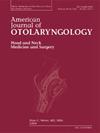Learning curves in endoscopic thyroidectomy: A literature review of different surgical approaches
IF 1.7
4区 医学
Q2 OTORHINOLARYNGOLOGY
引用次数: 0
Abstract
Objective
This review analyzes the learning curves of various endoscopic thyroidectomy approaches, aiming to guide surgeons in improving training efficiency, reducing learning time, and enhancing surgical safety and outcomes.
Methods
A literature search in PubMed and Web of Science for studies published from January 2014 to April 2024 on the learning curves of endoscopic thyroidectomy was conducted. Studies involving human subjects with specific case data were included; duplicates, non-English publications, animal studies, reviews, and unrelated thyroid conditions were excluded.
Results
A total of 47 studies were reviewed, covering various endoscopic thyroidectomy techniques. The trans-axillary procedure showed a learning curve peak between 30 and 90 cases (average 45.5 for endoscopic, 34.17 for robotic). The trans-breast/chest approach peaked between 25 and 60 cases (average 34.88). Transoral procedures peaked between 12 and 71 cases (average 37 for endoscopic, 28.63 for robotic). The bilateral axillo-breast approach (BABA) peaked at 30 cases for endoscopic surgeries and 15-51 cases for robotic-assisted surgeries (average 36.44).
Conclusion
This study highlights the learning curve differences among various approaches to endoscopic thyroidectomy, providing valuable insights for improving training and increasing the adoption of these techniques.
内镜甲状腺切除术的学习曲线:不同手术入路的文献综述
目的分析各种内镜甲状腺切除术入路的学习曲线,旨在指导外科医生提高培训效率,缩短学习时间,提高手术安全性和效果。方法检索2014年1月至2024年4月在PubMed和Web of Science上发表的关于内镜下甲状腺切除术学习曲线的文献。纳入了具有特定病例资料的人类受试者研究;排除重复、非英文出版物、动物研究、综述和不相关的甲状腺疾病。结果回顾了47项研究,涵盖了各种内镜下甲状腺切除术技术。经腋窝手术的学习曲线峰值在30 - 90例之间(内窥镜手术平均45.5,机器人手术平均34.17)。经胸入路25 ~ 60例(平均34.88例)。经口手术在12 - 71例之间达到高峰(内镜手术平均37例,机器人手术平均28.63例)。双侧腋窝-乳房入路(BABA)在内镜手术中最多30例,在机器人辅助手术中最多15-51例(平均36.44例)。结论本研究突出了内镜甲状腺切除术不同入路的学习曲线差异,为改进培训和提高这些技术的采用提供了有价值的见解。
本文章由计算机程序翻译,如有差异,请以英文原文为准。
求助全文
约1分钟内获得全文
求助全文
来源期刊

American Journal of Otolaryngology
医学-耳鼻喉科学
CiteScore
4.40
自引率
4.00%
发文量
378
审稿时长
41 days
期刊介绍:
Be fully informed about developments in otology, neurotology, audiology, rhinology, allergy, laryngology, speech science, bronchoesophagology, facial plastic surgery, and head and neck surgery. Featured sections include original contributions, grand rounds, current reviews, case reports and socioeconomics.
 求助内容:
求助内容: 应助结果提醒方式:
应助结果提醒方式:


